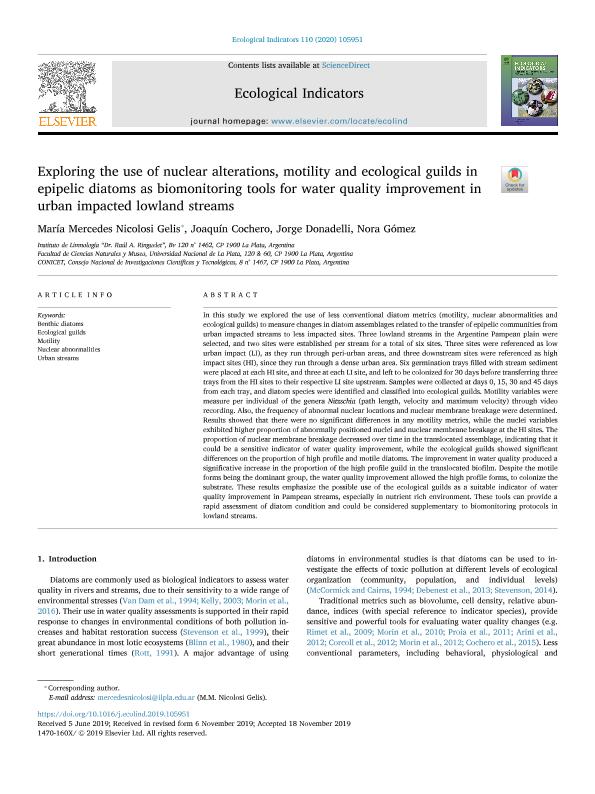Mostrar el registro sencillo del ítem
dc.contributor.author
Nicolosi Gelis, María Mercedes

dc.contributor.author
Cochero, Joaquin

dc.contributor.author
Donadelli, Jorge Luis

dc.contributor.author
Gomez, Nora

dc.date.available
2021-03-12T14:25:06Z
dc.date.issued
2020-03
dc.identifier.citation
Nicolosi Gelis, María Mercedes; Cochero, Joaquin; Donadelli, Jorge Luis; Gomez, Nora; Exploring the use of nuclear alterations, motility and ecological guilds in epipelic diatoms as biomonitoring tools for water quality improvement in urban impacted lowland streams; Elsevier Science; Ecological Indicators; 110; 3-2020; 1-8
dc.identifier.issn
1470-160X
dc.identifier.uri
http://hdl.handle.net/11336/128216
dc.description.abstract
In this study we explored the use of less conventional diatom metrics (motility, nuclear abnormalities and ecological guilds) to measure changes in diatom assemblages related to the transfer of epipelic communities from urban impacted streams to less impacted sites. Three lowland streams in the Argentine Pampean plain were selected, and two sites were established per stream for a total of six sites. Three sites were referenced as low urban impact (LI), as they run through peri-urban areas, and three downstream sites were referenced as high impact sites (HI), since they run through a dense urban area. Six germination trays filled with stream sediment were placed at each HI site, and three at each LI site, and left to be colonized for 30 days before transferring three trays from the HI sites to their respective LI site upstream. Samples were collected at days 0, 15, 30 and 45 days from each tray, and diatom species were identified and classified into ecological guilds. Motility variables were measure per individual of the genera Nitzschia (path length, velocity and maximum velocity) through video recording. Also, the frequency of abnormal nuclear locations and nuclear membrane breakage were determined. Results showed that there were no significant differences in any motility metrics, while the nuclei variables exhibited higher proportion of abnormally positioned nuclei and nuclear membrane breakage at the HI sites. The proportion of nuclear membrane breakage decreased over time in the translocated assemblage, indicating that it could be a sensitive indicator of water quality improvement, while the ecological guilds showed significant differences on the proportion of high profile and motile diatoms. The improvement in water quality produced a significative increase in the proportion of the high profile guild in the translocated biofilm. Despite the motile forms being the dominant group, the water quality improvement allowed the high profile forms, to colonize the substrate. These results emphasize the possible use of the ecological guilds as a suitable indicator of water quality improvement in Pampean streams, especially in nutrient rich environment. These tools can provide a rapid assessment of diatom condition and could be considered supplementary to biomonitoring protocols in lowland streams.
dc.format
application/pdf
dc.language.iso
eng
dc.publisher
Elsevier Science

dc.rights
info:eu-repo/semantics/openAccess
dc.rights.uri
https://creativecommons.org/licenses/by-nc-nd/2.5/ar/
dc.subject
BENTHIC DIATOMS
dc.subject
ECOLOGICAL GUILDS
dc.subject
MOTILITY
dc.subject
NUCLEAR ABNORMALITIES
dc.subject
URBAN STREAMS
dc.subject.classification
Ciencias Medioambientales

dc.subject.classification
Ciencias de la Tierra y relacionadas con el Medio Ambiente

dc.subject.classification
CIENCIAS NATURALES Y EXACTAS

dc.title
Exploring the use of nuclear alterations, motility and ecological guilds in epipelic diatoms as biomonitoring tools for water quality improvement in urban impacted lowland streams
dc.type
info:eu-repo/semantics/article
dc.type
info:ar-repo/semantics/artículo
dc.type
info:eu-repo/semantics/publishedVersion
dc.date.updated
2020-05-19T18:52:08Z
dc.journal.volume
110
dc.journal.pagination
1-8
dc.journal.pais
Países Bajos

dc.journal.ciudad
Amsterdam
dc.description.fil
Fil: Nicolosi Gelis, María Mercedes. Consejo Nacional de Investigaciones Científicas y Técnicas. Centro Científico Tecnológico Conicet - La Plata. Instituto de Limnología "Dr. Raúl A. Ringuelet". Universidad Nacional de La Plata. Facultad de Ciencias Naturales y Museo. Instituto de Limnología; Argentina
dc.description.fil
Fil: Cochero, Joaquin. Consejo Nacional de Investigaciones Científicas y Técnicas. Centro Científico Tecnológico Conicet - La Plata. Instituto de Limnología "Dr. Raúl A. Ringuelet". Universidad Nacional de La Plata. Facultad de Ciencias Naturales y Museo. Instituto de Limnología; Argentina
dc.description.fil
Fil: Donadelli, Jorge Luis. Consejo Nacional de Investigaciones Científicas y Técnicas. Centro Científico Tecnológico Conicet - La Plata. Instituto de Limnología "Dr. Raúl A. Ringuelet". Universidad Nacional de La Plata. Facultad de Ciencias Naturales y Museo. Instituto de Limnología; Argentina
dc.description.fil
Fil: Gomez, Nora. Consejo Nacional de Investigaciones Científicas y Técnicas. Centro Científico Tecnológico Conicet - La Plata. Instituto de Limnología "Dr. Raúl A. Ringuelet". Universidad Nacional de La Plata. Facultad de Ciencias Naturales y Museo. Instituto de Limnología; Argentina
dc.journal.title
Ecological Indicators

dc.relation.alternativeid
info:eu-repo/semantics/altIdentifier/url/https://www.sciencedirect.com/science/article/pii/S1470160X1930946X?dgcid=author
dc.relation.alternativeid
info:eu-repo/semantics/altIdentifier/doi/http://dx.doi.org/10.1016/j.ecolind.2019.105951
Archivos asociados
